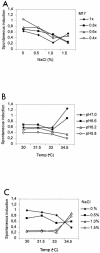Effects of diverse environmental conditions on {phi}LC3 prophage stability in Lactococcus lactis
- PMID: 15691922
- PMCID: PMC546743
- DOI: 10.1128/AEM.71.2.721-727.2005
Effects of diverse environmental conditions on {phi}LC3 prophage stability in Lactococcus lactis
Abstract
The effects of various growth conditions on spontaneous phiLC3 prophage induction in Lactococcus lactis subsp. cremoris IMN-C1814 was analyzed with a half fraction of a 4(4) factorial experimental design. The four factors included in the study were nutrient availability, acidity, osmolarity, and temperature, each applied at four levels. These environmental factors are related to the fermentation processes in the dairy industry, in which bacteriophage attacks on sensitive starter strains are a constant threat to successful fermentation processes. The frequency of spontaneous phiLC3 induction was determined by quantitative analyses of restored DNA attachment sites (attB) on the bacterial chromosomes in a population of lysogenic cells. Statistical analysis revealed that all four environmental factors tested affected phiLC3 prophage stability and that the environmental factors were involved in interactions (interactions exist when the effect of one factor depends on the level of another factor). The spontaneous phiLC3 induction frequency varied from 0.08 to 1.76%. In general, the induction frequency remained at the same rate or decreased when level 1 to 3 of the four environmental factors was applied. At level 4, which generally gave the least favorable growth conditions, the induction frequency was either unchanged, decreased, or increased, depending on the type of stress. It appeared that the spontaneous induction frequency was independent of the growth behavior of the host. It was the environmental growth conditions that were the decisive factor in induction frequency.
Figures



References
-
- Bissonnette, F., S. Labrie, H. Deveau, M. Lamoureux, and S. Moineau. 2000. Characterization of mesophilic mixed starter cultures used for the manufacture of aged cheddar cheese. J. Dairy Sci. 83:620-627. - PubMed
-
- Blatny, J. M., L. Godager, M. Lunde, and I. F. Nes. 2004. Complete genome sequence of the Lactococcus lactis temperate phage φLC3: comparative analysis of φLC3 and its relatives in lactococci and streptococci. Virology 318:231-244. - PubMed
-
- Blatny, J. M., P. A. Risoen, D. Lillehaug, M. Lunde, and I. F. Nes. 2001. Analysis of a regulator involved in the genetic switch between lysis and lysogeny of the temperate Lactococcus lactis phage φLC3. Mol. Genet. Genomics 265:189-197. - PubMed
-
- Blatny, J. M., M. Ventura, E. M. Rosenhaven, P. A. Risoen, M. Lunde, H. Brussow, and I. F. Nes. 2003. Transcriptional analysis of the genetic elements involved in the lysogeny/lysis switch in the temperate lactococcal bacteriophage φLC3, and identification of the Cro-like protein ORF76. Mol. Genet. Genomics 269:487-498. - PubMed
-
- Bouchard, J. D., and S. Moineau. 2000. Homologous recombination between a lactococcal bacteriophage and the chromosome of its host strain. Virology 270:65-75. - PubMed
Publication types
MeSH terms
Substances
LinkOut - more resources
Full Text Sources

